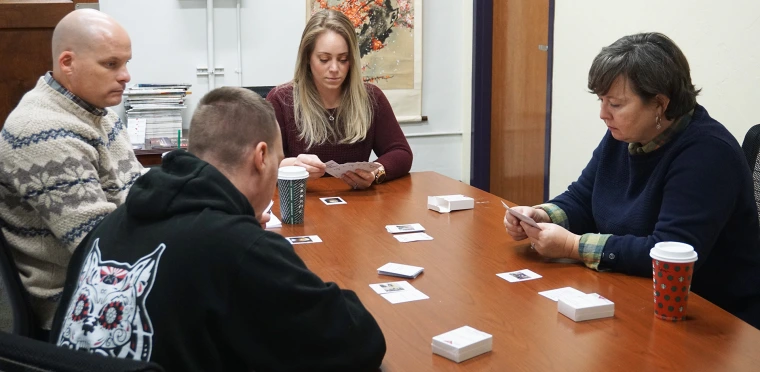
Designing for Better Outcomes
Over the last five years, there has been a substantial rise in the popularity of tabletop gaming, driven by younger generations.[1][2] The Western Mining Safety and Health Training Resource Center is developing new tabletop games for learning, or serious games, to capitalize on this trend. These group activities enhance learning by using shared visual artifacts and cooperative or competitive tasks embedded in a compelling story.
When designing a serious game, the learning content may be incorporated by using an endogenous or exogenous approach.[3] With an endogenous approach, the story and game mechanics are closely coupled to the learning objectives. Ideally, the learner will not distinguish between the story and the learning content. Conversely, an exogenous approach involves a game that has no relation to the learning content. For example, consider a board game designed to teach mathematics, where the player cannot move his or her pawn until a "multiply" operation is done correctly. The board game is exogenous to the math lesson, as math has nothing to do with either the story or the game mechanics.
Research suggests that endogenous approaches can lead to better outcomes.[3][4] Endogenous games more fully immerse the user in the learning, which triggers flow state.[5] The Center carefully designs its serious games around the endogenous approach to maximize learning outcomes.
Our tabletop offerings, which include Escape!, MSHA Football, Mining Strong, Very Good Day, and Coming Home Alive, are available on high-quality print media at no cost to our training partners. For trainers wishing to print or modify their own materials, the games and related resources are also available as digital downloads through this web portal. See below for details.
Escape! is a cooperative card game for 1-5 players where teams must escape an underground mine before the game time runs out. At the end of the game, players will be able to:
- Make decisions under pressure identity in a self-escape situation
- Identify the most useful resources in an emergency
- Recognize the implications of changing conditions
Players face changing conditions and unexpected challenges as they make their way to the mine portal. They will have to make important decisions about their evacuation route, assess risks, and leverage available resources. Players lose if their health meter reaches 0, and they win if they can reach the mine portal.
Escape! is in the prototyping stage with an anticipated release of Q3 2023. An online testing version may be found at Playingcards.io. Additional virtual playing rooms are available upon request.
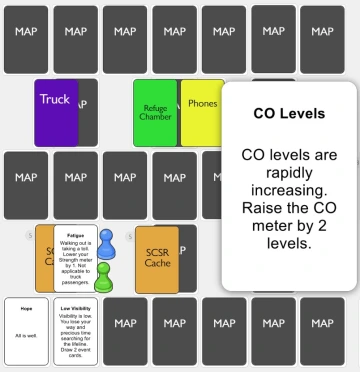

Quick Facts: Escape!
| Media Type | Card Game / Online Game |
| Primary Authors | Rustin Reed, Eric Lutz, Leonard Brown |
| Training Topics | Emergency Mine Evacuation, Self Escape, Risk Assessments |
| Primary Sectors | All Sectors |
| Number of Players | 1-5 players |
| Activity Time | 30 minutes |
| Requirements | None |
| Train-the-Trainer? | Under Development |
| Customizable? | Yes |
| Downloads | Under Development (Q3 2023 Release) |
| Online Versions | Beta Test Room (Playingcards.io) |
| Expansion Packs | Anticipated as Future Work |
MSHA Football
MSHA Football is a team-based synthesis activity where participants test their knowledge on a variety of mining health and safety topics and best practices. The game assesses health and safety topics covered by 8-hour annual refresher in fun, non-threatening format.
MSHA Football approximates the rules of real Football using a printed card game and app. Each team takes turns playing offense and answering challenge questions to advance the ball down the field. When the offense answers a Question Card correctly, a card is drawn from the Play Card deck, determining the next play. The football advances until a team scores or loses possession. The game ends when all questions have been answered. The team with the highest score wins.
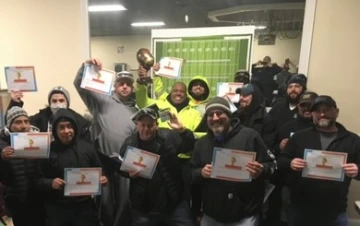
The Center offers professionally printed gaming materials, including card deck and instructional guides. The cards are printed to flexible card stock with rounded corners and polymer laminate to increase durability. Each deck includes 104 playing cards and instructional sheet in a convenient shrink-wrapped storage box. If your organization is interested in acquiring printed decks, please contact us. The materials are also available as a download (see below). The center offers a train-the-trainer workshop to help you integrate MSHA Football into your training curriculum.
We have developed a Scoreboard app to make tracking the football and team scores more visual and fun. The Scoreboard app is available for Microsoft Windows (8/10/11) PCs as a portable executable (no install necessary).
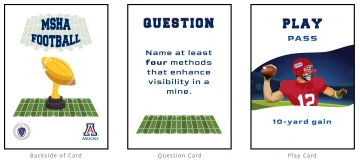
Quick Facts: MSHA Football
| Media Type | Card Game + Desktop App |
| Primary Authors | Danny C.K. Lee, Ngan Pham, Tuan Bui, Leonard Brown |
| Training Topics | Annual Refresher Topics, Training Synthesis |
| Primary Sectors | All Sectors |
| Number of Players | Up to 24 players |
| Activity Time | 20-30 minutes |
| Requirements | None |
| Train-the-Trainer? | Available (Recommended) |
| Customizable? | Yes |
| Downloads | Card Deck Templates (229 MB ZIP), Instruction Sheet (PDF), MSHA Football Certificate (PDF), MSHA Scoreboard App (Windows Exe, 30 MB ZIP) |
| Expansion Packs | Anticipated as Future Work |
Mining Strong is a cooperative card game for 1-5 players where teams must identify and implement various controls that reduce health hazards and improve wellness. Two versions of the game have been developed: The Industrial Hygiene (IH) version consider occupational health hazards such as silica, noise, and ergonomics, while the Total Worker Health (TWH) version considers strategies to improve wellness, including nutrition, exercise, and fatigue. At the end of the game, players will be able to describe 7-10 controls for industrial hygiene hazards or 7-10 strategies for improving personal wellness, respectively.
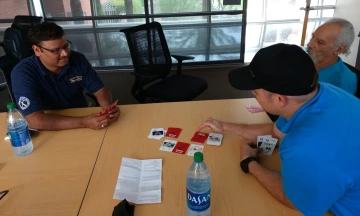
Once teams have identified appropriate controls or wellness strategies, they will then explore methods to implement these controls and strategies effectively. Teams defeat the game by effectively controlling all hazards. Mining Strong has been beta-tested by more than a dozen trainers.
The Center offers professionally printed gaming materials, including card deck and instructional guides. The cards are printed to flexible card stock with rounded corners and polymer laminate to increase durability. Each deck (IH or TWH) includes 52 playing cards and instructional sheet in a convenient shrink-wrapped storage box. If your organization is interested in acquiring printed decks, please contact us. The materials are also available as a download (see below). The center offers a train-the-trainer workshop to help you integrate Mining Strong into your training curriculum.
For online courses, the Center offers web-based editions of Mining Strong which are hosted by Playingcards.io. Additional virtual playing rooms are available upon request.
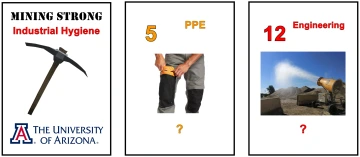
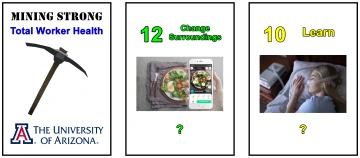
Quick Facts: Mining Strong
| Media Type | Card Game / Online Game |
| Primary Authors | Rustin Reed |
| Training Topics | Health Hazards, NIOSH Total Worker Health, Wellness Strategies |
| Primary Sectors | All Sectors |
| Number of Players | 1-5 players per card deck |
| Activity Time | 30 minutes |
| Requirements | None |
| Train-the-Trainer? | Available (Recommended) |
| Customizable? | Yes |
| Downloads | Card Deck Templates, IH (56 MB ZIP), Instruction Sheet, IH (PDF) Card Deck Templates, TWH (70 MB ZIP), Instruction Sheet, TWH (PDF) |
| Online Versions | Industrial Hygiene: Room 1, Room 2, Room 3 Total Worker Health: Room 1, Room 2, Room 3 |
| Expansion Packs | Anticipated as Future Work |
Very Good Day is a modular card game for hazards recognition and mitigation. Although the card deck includes work areas for Metal/Non-metal mines (surface and underground), it incorporates hazards suitable to all mining sectors and is easily modified to incorporate other work areas and site-specific customizations. Very Good Day now includes an expansion pack addressing miner health, providing a total of 104 playing cards.
The game employs a matching mechanic with three card types: Area, hazard, and control. Area cards show various mine work areas, such as conveyors, highwalls, processing facilities, roadways, and maintenance shops. Each player is randomly dealt an area card and becomes “supervisor” of that work area for the duration of the game. On each turn, players select a random hazard card from the stack. Hazard selections were based on three sources, each representing a tier of risk severity:
- HIGH: MSHA fatality reports
- MEDIUM: Top 10 MSHA reportable injuries
- LOW: Common yet frequently missed hazards[6]
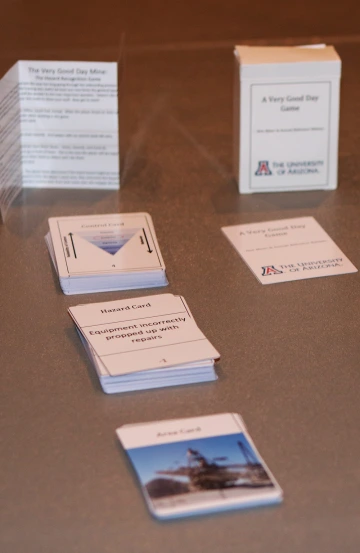
Each hazard must be mitigated, if possible, using one of the player’s control cards. A control card indicates one of five random levels in the hierarchy of critical controls. The control levels include elimination, substitution, engineering, administrative, and personal protective equipment (PPE). The first player to use up his or her control cards, by properly mitigating hazards in the work area, wins the game.

Very Good Day has been play tested with over 500 mine workers to date. Trainers often comment on the high level of engagement, ease of play, and spontaneous, on-topic conversations that the game elicits around hazards recognition and mitigation. Anecdotal evidence from testing suggests that gameplay with larger groups may increase discussion and competitiveness in ways that are beneficial to learning.[7] For more information on the game design and testing, please see the technical report (PDF).
The Center offers professionally printed gaming materials, including card deck and instructional guides. The cards are printed to flexible card stock with rounded corners and polymer laminate to increase durability. Each deck includes 104 playing cards, score card, and instructional sheet in a convenient shrink-wrapped storage box. If your organization is interested in acquiring printed decks, please contact us. The materials are also available as a download (see below). The center offers a train-the-trainer workshop to help you integrate Very Good Day into your training curriculum.
For online courses, the Center offers web-based editions of Very Good Day which are hosted by Playingcards.io. Additional virtual playing rooms are available upon request.
Quick Facts: Very Good Day
| Media Type | Card Game / Online Game |
| Primary Authors | Laurie Wilson, Michelle Lutz, Eric Lutz |
| Training Topics | Hazards Recognition, Hierarchy of Controls |
| Primary Sectors | All Sectors |
| Number of Players | 2-5 players per card deck |
| Activity Time | 30-60 minutes |
| Requirements | None |
| Train-the-Trainer? | Available (Recommended) |
| Customizable? | Yes |
| Downloads | Card Deck Templates, v2.0 (3.92 MB ZIP), Instruction Sheet (PDF) |
| Online Versions | Room 1, Room 2, Room 3 (Playingcards.io) |
| Expansion Packs | Miner Health (Now Included) |


Coming Home Alive is an upcoming hybrid game that will bridge traditional tabletop activities with the power and versatility of computer-based learning environments, such as Harry's Hazardous Day. By combining recent trends in gaming with the ubiquity of mobile devices such as smartphones and tablets, the Center will help organizations move toward a technology-enabled training curriculum for safety and health.
Coming Home Alive features a shared physical game board and player pawns that are augmented by personalized training content using apps on mobile devices. Players will participate in cooperative and competitive gameplay to achieve rewards (incident free hours) or penalties (citations from the mine inspector) as they advance through a story about production or maintenance. As learners move among locations on the game board, which shows an overview of the worksite, they will respond to context-specific challenges on their mobile devices. Responses will be evaluated based on the current configuration of the game board. An instructor or other expert may optionally play the role of Mine Inspector to evaluate player responses. Coming Home Alive is currently under development and will begin play testing with industry partners in Q3 of 2023.
Quick Facts: Coming Home Alive
| Media Type | App-based Game |
| Primary Authors | Leonard Brown, Rustin Reed, Tuan Bui, Ngan Pham |
| Training Topics | Blasting Safety, Ground Control, Haul Trucks, Hazard Recognition, Moving Equipment |
| Primary Sectors | Metal / Non-Metal (Surface), Stone, Sand, and Gravel |
| Number of Players | 2-8 players |
| Activity Time | 10-20 minutes |
| Requirements | Smartphones or Tablets (Android, iPhone) required. |
| Train-the-Trainer? | Under Development |
| Customizable? | Yes |
| Downloads | Under Development (Q4 2023 Release) |
| Expansion Packs | Anticipated as Future Work |
- British Broadcasting Corp. (2019, Sept. 28). "Board Games: Why are They Becoming so Popular?" British Broadcasting Corp. Available at BBC
- Graham, L. (2016, Dec. 22). "Millennials are Driving the Board Games Revival." CNBC. Available at CNBC
- Wilson, K.A., Bedwell, W.L., Lazzara, E.H., Salas, E., Burke, C.S., Estock, J.L., Orvis, K.L., & Conkey, C. (2009). "Relationships Between Game Attributes and Learning Outcomes." Simulation and Gaming, 40 (2), pp. 217-266. https://doi.org/10.1177/1046878108321866
- Garris, R., Ahlers, R., & Driskell, J.E. (2002). "Games, Motivation, and Learning: A Research and Practice Model." Simulation and Gaming, 33(4), pp. 441-467. https://doi.org/10.1177/1046878102238607
- Rieber, L. (1996). "Seriously Considering Play: Designing Interactive Learning Environments Based on the Blending of Microworlds, Simulations, and Games." Education and Technology Research and Development, 44(2), pp. 43-58. https://doi.org/10.1007/BF02300540
- Eiter, B., et al. (2017). "Recognizing Mine Site Hazards: Identifying Differences in Hazard Recognition Ability for Experienced and New Mineworkers." In Cassenti, D. (ed.), Applied Human Factors and Ergonomics 2017. LNCS 591, pp. 104-115. Springer: Heidelberg. https://doi.org/10.1007/978-3-319-60591-3_10
- Wilson, L., Brown, L.D., Reed, R. & Burgess, J. (2020) "Gamification of Hazard Recognition in Mining with a Tabletop Card Game," In Cassenti, D. (ed.), Applied Human Factors and Ergonomics 2020. LNCS. Springer: Heidelberg. (In press)

